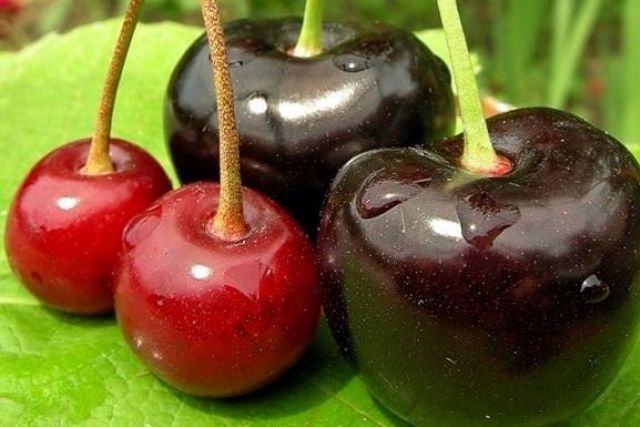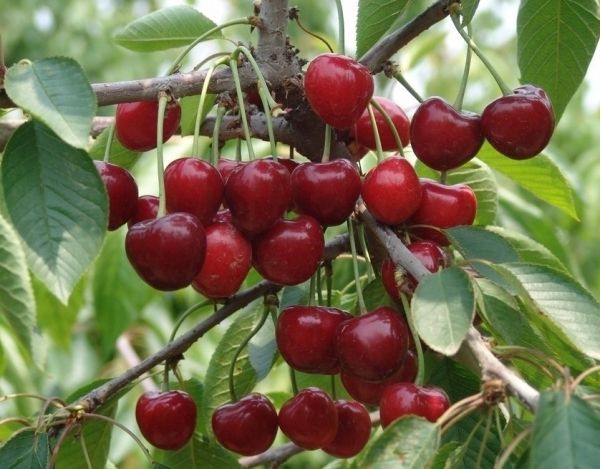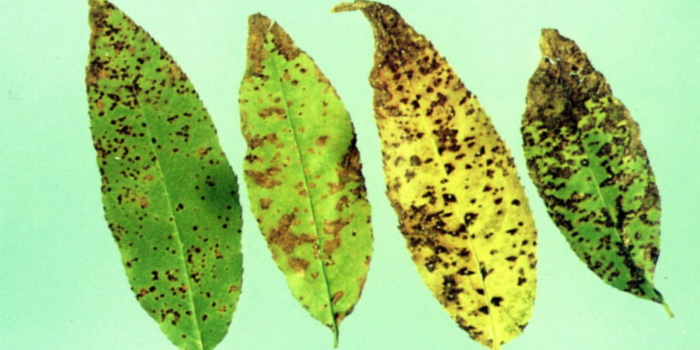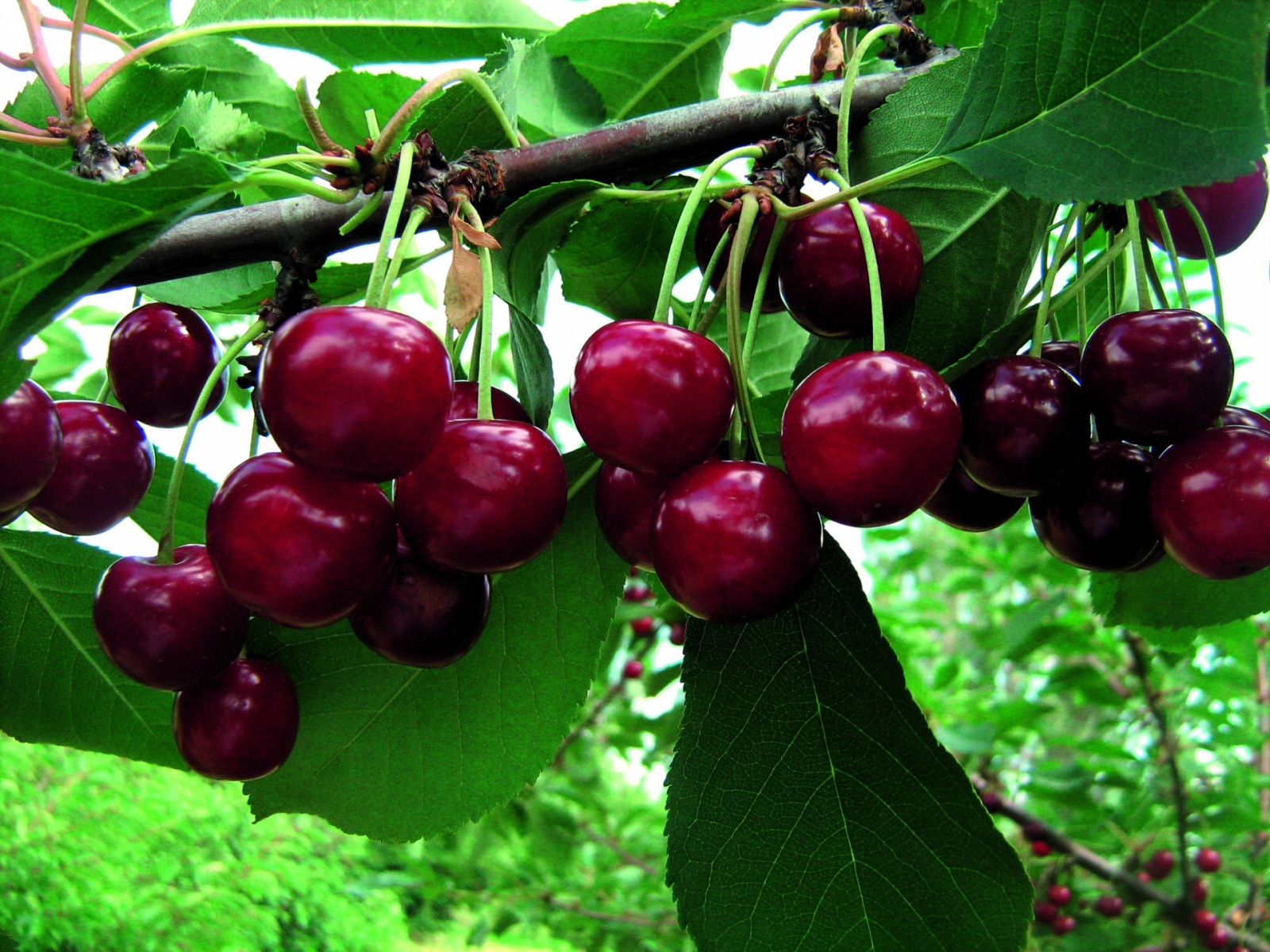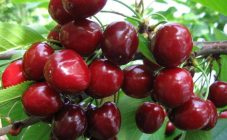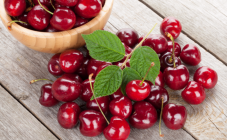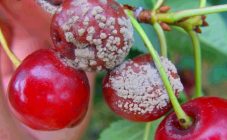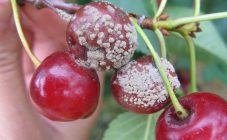Content:
Cherry and sweet cherry are woody fruit and berry plants grown in gardens. They have a lot in common, but there are also significant differences.
Scientific classification
Kingdom: Plants.
Department: Flowering.
Class: Dicotyledons.
Order: Rosaceae.
Family: Pink.
Rod: Plum.
As can be seen from the classification, cherry and sweet cherry are two different species of the same genus Plum. Despite belonging to the same taxonomic group, these two tree species should be distinguished.
Botanical description
Putting before oneself the question of how cherry differs from sweet cherry, first of all, one should turn to botanical characteristics.
Cherry can have the life form of a tree or shrub and grow up to 10 m. The leaves are petiolate (i.e. have a petiole that attaches to the stem). The flowers are pure white. The fruit, called drupe, contains vitamin C and has a sweet and sour taste, can reach 2 cm in circumference. It blooms mainly in March-April, begins to bear fruit from the end of May.
Sweet cherry, unlike cherry, has a larger fruit, the color of which can be yellow, red, pink or black. The berries are sweet. Begins to bloom in May, bears fruit from June.
Varieties
Cultivated varieties of cherries have many similarities, and sometimes even an experienced gardener can not easily distinguish between them.
Popular varieties of common cherries are:
- Anadolskaya. A massively widespread variety. Growing area - Dagestan. The tree can be up to 5 m high. Fruits weighing 4-5 g are considered large enough. Approximately 10 kg of berries can be harvested from one tree. The variety is immune to many ailments and common pests.
- Crimson. The height of the tree reaches 2 m. Fruit weight is about 3 g. Fruits in July. The variety is poorly resistant to fungi.
- Vladimirskaya. Bushy tree. The taste of the fruit is sweet and sour. The cultivation area is the middle zone of Russia.
- Zhukovskaya. The berries are mostly large, their weight is 4-7 g. The variety is resistant to many diseases. Does not crumble. During the season, you can harvest 12 kg from one tree, so the variety belongs to the medium-yielding variety.
- Lyubskaya. Zoned in the North-West, Central, Middle Volga, Lower Volga and North Caucasian regions. The height of the trees is small (up to 2 m). Berries weighing up to 5 g. The taste is intense. The variety ripens late. Resistance to fungal diseases is low, therefore continuous, timely treatment with fungicides is recommended.
- Maraskinovaya. The fruits have almost no pulp, which in many cases is considered a disadvantage. But the unusual smell of almonds makes this cherry variety a valuable crop. The taste is bitter. Cultivated in Italy.
- In memory of Vavilov. The growth of the tree is quite large. The mass of the berries is 4 g, their color is dark red. The maximum yield is 22 kg per tree. Poorly resistant to fungal diseases. The name of the variety is dedicated to the Soviet botanist and breeder N.V. Vavilov.
- Memory of Sakharov. Medium height tree. The mass of one berry is about 3.5 g. The taste is sweet. The advantages of this variety are manifested in its resistance to low temperatures and good yield, which is usually 12 kg per tree. The flaws include non-simultaneous ripening of fruits, which provokes gardeners to harvest several times a season.
- Rossoshanskaya black.A mature tree does not exceed 4 m. The berries are black, large, and have a pleasant sour taste. The average yield is 16 kg per tree, the maximum yield is 25 kg.
- Turgenevka. Fruits are large, weighing up to 5 g. Their diameter can be about 2 cm. Cultivated in central Russia.
- Kharitonovskaya. The height of the tree ranges from 2 to 2.5 m. The cherry crown grows well in width, therefore, when planting a garden, it is recommended to make large distances between trees. The weight of the berries is usually no more than 5 g. The disadvantage is the large size of the seed.
- Black large. The variety is zoned for the North Caucasian region of the Russian Federation. It is also widely distributed in the Volgograd, Rostov, Belgorod and Voronezh regions. The tree reaches a height of 4 m. The berries are relatively large. The pulp tastes sweet. Productivity is high (15-25 kg of berries from one tree). The lifespan of the variety does not exceed 15 years. Yields decrease with age.
- Saratov baby. It is a hybrid of cherry and sweet cherry. Good cold resistance is an advantage. The height of the tree is 2-2.5 m. The fruits weigh 5 g each. The crop can be harvested at the end of June.
Among the common varieties of cherries, the following can be distinguished:
- Adeline. The height of the tree is small, usually about 3 m. The weight of the berries is 5-6 g. The yield increases with age (up to 25 kg can be harvested from one tree). The berries ripen in several stages. The variety grows in the climate of the Central Black Earth Region.
- Scarlet. The fruits are large, their weight is 9 or 10 g. It blooms in medium terms, ripens rather late.
- Annushka. The height of the tree varies between 4 and 5 m. Fruit weight is 8-10 g, the taste is sweet. The advantages are good cold resistance, significant yield (just over 20 kg per season). Needs systematic crown pruning. Susceptible to humid climates.
- Ariadne. Fruits are medium in size, weighing up to 6 g. Ripens early. Grows in the North Caucasian region.
- Velvet. It is a medium-sized tree. The taste of the fruit is sugary-sweet, the weight of one berry is up to 7 g. The yield is high.
- Bereket. The fruits are large and have a rounded shape. The pulp is rich. The berries ripen early.
- Bigarro Burlat. Widely distributed in Central Europe. Medium sized tree. The variety is slightly resistant to fungi. The fruits are prone to cracking.
- Bryansk pink. Zoned in the Central region of the Russian Federation. Fruits weighing 4 g. The taste is sweet, slightly bitter. Fruiting later. The average yield is 20 kg per tree. The variety is highly resistant to known fungal diseases.
- Valery Chkalov. Early terms of fruit formation are inherent. The average weight of berries varies between 7 and 8 g. The maximum yield of one tree is 60 kg, which is unsatisfactory.
- Gronkavaya. Fruit weight 5 g. Sweet taste. The advantages of the variety are its winter hardiness and resistance to fungal diseases.
- Dagestan early. The fruits are large, weighing 7 g. The taste is sweet and sour. The stone is rather small and easily separates from the pulp. The yield is predominantly high.
- Dybera black. Zoned in the North Caucasian and Lower Volga regions. The tree is medium-sized. The fruits are large, the weight is 7 g. The variety has a colossal yield (the maximum is 170 kg per tree). The downside is the tendency to be affected by gray mold.
- Demeter. Fruits weighing 7.5 g. The variety belongs to the mid-early period of development. Differs in high taste and marketability.
- Dessert. The variety develops early. Fruits weighing 4-5 g. Taste with sourness.
Dolores. A tree up to 4 m high. Fruit weight is 6-7 g. Fruit ripening is typical for the second half of June. The yield per tree is 25 kg. The variety is drought-resistant, does not need stable pruning. - Caucasian. The fruits are generally large, up to 2.5 cm in diameter and weighing 7 g. The advantage of the variety is its tolerance to fungal diseases.
- Yaroslavna. The height of the tree is up to 3.5 m.The fruits are rather large, weighing from 8 to 12 g. The taste is slightly sour, but pleasant. The variety is resistant to cold and drought. High yields and the lack of a tendency to cracking berries are among the obvious advantages.
- Spunk. The tree is quite tall (up to 6 m). One berry weighs 5 g. To maintain high yields, gardeners need to carry out regular pruning.
Requirements for environmental factors
Temperature, light, humidity and nutrition are important for the growth and development of fruit crops.
- Temperature. Cherry can withstand low temperatures well, therefore it grows favorably in the northern regions. Sweet cherry is a thermophilic fruit crop; southern regions are preferred for it.
- Illumination. Cherries and sweet cherries are light-loving plants.
- Humidity. Cherries and sweet cherries are moisture-loving crops that require mandatory watering during fruiting.
- Nutrition. For the favorable growth and development of fruit trees, it is necessary to apply organic and mineral fertilizers to the soil. It is advisable to apply foliar feeding. With this method, cherries and cherries absorb nutrients through the foliage.
Diseases and pests
Common diseases and pests of fruit crops can lead to the death of trees. Therefore, it is important to guess the symptoms in time and use effective control and protection measures.
Among the common pests of cherries and cherries, the following can be distinguished:
- Cherry weevil. Beetles are golden-reddish in color. They feed on buds, flowers, fruits and foliage. Insecticides are used as a control measure.
- Slimy sawfly. Greenish-black larvae. The juicy part of the young leaves is eaten out. To combat the sawfly, chemical means of protection are used.
- Aphid. The insect settles on the underside of the leaf blade. Leads to deformation of leaves and stems. In addition to the use of insecticides, it is necessary to observe agricultural techniques (prune damaged shoots, do not apply excessive amounts of nitrogen fertilizers).
- Cherry fly. The larvae feed on fruits and damage the leaves.
- Hawthorn butterfly. Caterpillars eat buds and foliage. An effective control measure is the spraying of insects with chemicals.
Popular diseases:
- Stem rot. The causative agent is the mushroom Ganoderma applanatum. The main symptom is yellowish white rot on wood. Trees become brittle, break easily. Control measures are expressed in spraying trees with chemicals, removing damaged parts.
- Monilial burn. The causative agent is the mushroom Monilia cinerea Bonord. With this disease, the leaves become brown. Timely spraying trees with a Bordeaux mixture (1% solution) can save a whole tree from death.
- Gommoz. Does not apply to infectious diseases. As a result of this type of ailment, gum is excreted abundantly. Mechanical damage to the bark occurs. To prevent the disease, it is necessary to comply with agrotechnical requirements.
- Chlorosis. The yellowing of the leaves is easily explained by the poor supply of nutrients to them. The reasons are the spread of various rot.
- Coccomycosis. The causative agent is the mushroom Coccomyces hiemalis Higgins. Dark brown spots appear on the leaves and fruits. A measure of control is spraying trees with a Bordeaux mixture and self-cutting pruning of damaged parts.
- Clasterosporium disease. The causative agent is the mushroom Clasterosporium sagpophilum. Reddish spots appear on the leaves. The fruits are deformed, dry out and become unusable.
- Brown spotting. The causative agent is the fungus Phyllosticta prunicola. Another name for the disease is phyllostictosis. Brown spots are formed on the bark. Then the dead tissue begins to crack and fall out, leaving holes.
- Witch's broom cherry. The causative agent is the mushroom Taphrina ceraci. On some branches, densely spaced shoots are formed, resembling bushes. Fruits are significantly affected. As a control measure, pruning and burning of the affected areas is carried out.
The appearance of individual parts of trees is different. Their difference lies not only in the shape and size of individual parts (leaves, shoots), the taste of berries, the amount of harvest, the periods of flowering and fruiting, but also in agrotechnological and environmental requirements. However, despite the differences between cherries and sweet cherries, they are threatened by common pests and diseases.
